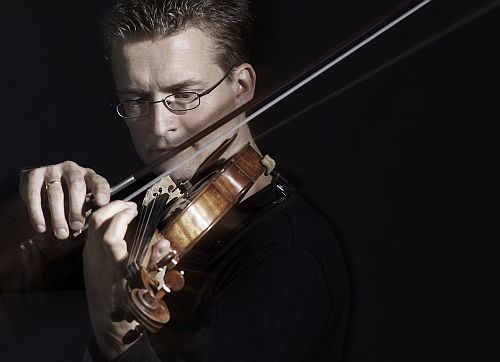
 Germany Elliott Carter, Beethoven, Schoenberg and Gershwin:Christian Tetzlaff (violin), St. Louis Symphony/David Robertson (conductor), Philharmonie, Berlin, 5.9.2012 (MC)
Germany Elliott Carter, Beethoven, Schoenberg and Gershwin:Christian Tetzlaff (violin), St. Louis Symphony/David Robertson (conductor), Philharmonie, Berlin, 5.9.2012 (MC)
Elliott Carter – Holiday Overture (1944, rev. 1961)
Beethoven – Violin Concerto (1806)
Schoenberg – Five Pieces for Orchestra, Op. 16 (1909)
Gershwin – An American in Paris (1928)

What a wonderful programme in prospect for the Berlin Philharmonie audience with an attendance that I estimate was running at about 80% of its capacity. A splendid mix of contrasting works comprising a rarely heard overture written in a very late-Romantic idiom from centenarian Elliott Carter, an early Romantic violin concerto by Beethoven (one of the most popular in the whole concerto repertoire), an innovative and concise orchestral score from Schoenberg and a sparkling orchestral showpiece from the pen of Gershwin. But an opportunity for an even better concert was missed, as too often conductor David Robertson’s choice of tempi and approach seemed less than judicious and the cadenzas employed by soloist Christian Tetzlaff in the Beethoven concerto were puzzlingly unfamiliar.
The St. Louis Symphony under music Director David Robertson opened the concert with Elliott Carter’s Holiday Overture from 1944 in its later 1961 revision. Carter’s melodically appealing nine minute long Holiday Overture seems a long way from the thorny and complex atonal music that he was writing from the early 1950s. With Robertson keeping the forward momentum going during the rollicking ride it was not difficult to hear the influences in Carter’s soundscape of his contemporaries Copland, Barber, Bernstein and occasionally that of Ives too. This is good humoured, feel good music with which the St. Louis Symphony seemed completely at home. A special mention is in order for the splendid St. Louis brass with their particularly pleasing timbre.
Beethoven’s Violin Concerto from 1806 a much loved staple of the repertoire suffered from humdrum accompaniment by the St. Louis Symphony. The opening movement sped along nicely, offering freshness and real bite with Christian Tetzlaff an assured and dexterous soloist. The Larghetto was another matter entirely with Tetzlaff and Robertson conspiring to provide a deathly slow opening and one of the most sluggish tempi I have experienced in the movement. Soloist and conductor went some way to redeem themselves in the Rondo, Allegro, Finale with playing that was brisk enough to blow away any cobwebs. The main bone of contention was Tetzlaff’s choice of cadenzas which etched puzzlement on many audience faces. My best guess was that they were Tetzlaff’s own arrangement of the cadenzas for the piano concerto version of the score. This was my first glimpse of Tetzlaff in the concert hall. He is a really assured violinist who looks completely relaxed and not opposed to placing his hand in his trouser pocket during rests. No hands in trousers from Tetzlaff for the enchanting encore he gave of the Gavotte en roundeau from J.S. Bach’s Solo Partita No. 3 in E major.
Written in 1909 at the request of Richard Strauss’s for the Berlin Hofkapelle concerts Schoenberg described his Five Pieces for Orchestra (Fünf Orchesterstücke), Op. 16 as being, “All about sound and mood…” they are a “bright, uninterrupted interchange of colors, rhythms and moods.” Using innovative expressive and compressive concepts these are five very brief programmatic pieces that Schoenberg gave titles. Just the thought of Schoenberg’s music can send shivers down the spine of the most battle hardened concert-goer but the Five Pieces for Orchestra are reasonably accessible works written before the composer fully embraced his highly challenging 12 tone system. The first piece, Premonitions, was given a dramatic reading, piece two, The Past, flowed beautifully and number three, Summer Morning by a Lake: Chord-Colors, was calm and unhurried. The bright opening of piece four, Peripetia, soon shifted to an anxiety laden atmosphere and the final piece, The Obbligato Recitative mainly for strings, is genial in mood with suggestions of nature renewing itself after a hard winter. I love this Schoenberg score and Robertson and his St. Louis players gave a perfectly acceptable reading with some pleasing individual contributions but where was the beguiling sense of steely beauty in the writing that the finest performances can summon from the score?
I can see how Gershwin’s brash, highly spirited tone poem American in Paris can be the perfect work to close an American themed concert programme. Commissioned by the New York Philharmonic the colourful score is intended, from the perspective of a visiting American, to capture the sights, sounds and vitality of Paris in the 1920s. But the impression given under Robertson’s direction was a decidedly lacklustre one. The workmanlike playing of the St. Louis players certainly lacked energy, atmosphere and most of all sufficient swing. In the last 12 months at the Bridgewater Manchester I have heard the CBSO under Carlos Kalmar in this very work and at the Salford Lowry the Hallé Orchestra under Sir Mark Elder playing Bernstein’s Wonderful Town both demonstrating how well an orchestra can swing. It was left to the ebullient encore of Bernstein’s Candide overture to do its job and send the Berlin audience home in high spirits.
Michael Cookson